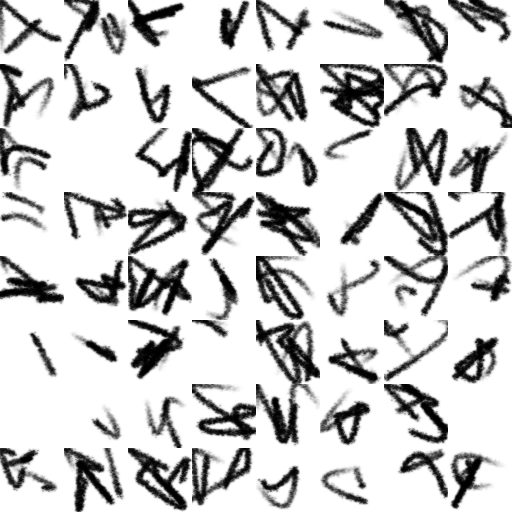carpedm20 / Spiral Tensorflow
Licence: other
in progress
Stars: ✭ 117
Programming Languages
python
139335 projects - #7 most used programming language
Projects that are alternatives of or similar to Spiral Tensorflow
Accel Brain Code
The purpose of this repository is to make prototypes as case study in the context of proof of concept(PoC) and research and development(R&D) that I have written in my website. The main research topics are Auto-Encoders in relation to the representation learning, the statistical machine learning for energy-based models, adversarial generation networks(GANs), Deep Reinforcement Learning such as Deep Q-Networks, semi-supervised learning, and neural network language model for natural language processing.
Stars: ✭ 166 (+41.88%)
Mutual labels: reinforcement-learning, generative-adversarial-network
Pytorch Rl
This repository contains model-free deep reinforcement learning algorithms implemented in Pytorch
Stars: ✭ 394 (+236.75%)
Mutual labels: reinforcement-learning, generative-adversarial-network
Gail Tf
Tensorflow implementation of generative adversarial imitation learning
Stars: ✭ 179 (+52.99%)
Mutual labels: reinforcement-learning, generative-adversarial-network
Mlds2018spring
Machine Learning and having it Deep and Structured (MLDS) in 2018 spring
Stars: ✭ 124 (+5.98%)
Mutual labels: reinforcement-learning, generative-adversarial-network
Udacity Deep Learning Nanodegree
This is just a collection of projects that made during my DEEPLEARNING NANODEGREE by UDACITY
Stars: ✭ 15 (-87.18%)
Mutual labels: reinforcement-learning, generative-adversarial-network
Kbgan
Code for "KBGAN: Adversarial Learning for Knowledge Graph Embeddings" https://arxiv.org/abs/1711.04071
Stars: ✭ 186 (+58.97%)
Mutual labels: reinforcement-learning, generative-adversarial-network
Awesome Tensorlayer
A curated list of dedicated resources and applications
Stars: ✭ 248 (+111.97%)
Mutual labels: reinforcement-learning, generative-adversarial-network
Leakgan
The codes of paper "Long Text Generation via Adversarial Training with Leaked Information" on AAAI 2018. Text generation using GAN and Hierarchical Reinforcement Learning.
Stars: ✭ 533 (+355.56%)
Mutual labels: reinforcement-learning, generative-adversarial-network
Pytorch Rl
PyTorch implementation of Deep Reinforcement Learning: Policy Gradient methods (TRPO, PPO, A2C) and Generative Adversarial Imitation Learning (GAIL). Fast Fisher vector product TRPO.
Stars: ✭ 658 (+462.39%)
Mutual labels: reinforcement-learning, generative-adversarial-network
Exposure
Learning infinite-resolution image processing with GAN and RL from unpaired image datasets, using a differentiable photo editing model.
Stars: ✭ 605 (+417.09%)
Mutual labels: reinforcement-learning, generative-adversarial-network
Deterministic Gail Pytorch
PyTorch implementation of Deterministic Generative Adversarial Imitation Learning (GAIL) for Off Policy learning
Stars: ✭ 44 (-62.39%)
Mutual labels: reinforcement-learning, generative-adversarial-network
Conversational Ai
Conversational AI Reading Materials
Stars: ✭ 34 (-70.94%)
Mutual labels: reinforcement-learning, generative-adversarial-network
Chemgan Challenge
Code for the paper: Benhenda, M. 2017. ChemGAN challenge for drug discovery: can AI reproduce natural chemical diversity? arXiv preprint arXiv:1708.08227.
Stars: ✭ 98 (-16.24%)
Mutual labels: reinforcement-learning, generative-adversarial-network
Studybook
Study E-Book(ComputerVision DeepLearning MachineLearning Math NLP Python ReinforcementLearning)
Stars: ✭ 1,457 (+1145.3%)
Mutual labels: reinforcement-learning
A Nice Mc
Code for "A-NICE-MC: Adversarial Training for MCMC"
Stars: ✭ 115 (-1.71%)
Mutual labels: generative-adversarial-network
Ctc Executioner
Master Thesis: Limit order placement with Reinforcement Learning
Stars: ✭ 112 (-4.27%)
Mutual labels: reinforcement-learning
Gpnd
Generative Probabilistic Novelty Detection with Adversarial Autoencoders
Stars: ✭ 112 (-4.27%)
Mutual labels: generative-adversarial-network
Reinforcement Learning An Introduction
Python Implementation of Reinforcement Learning: An Introduction
Stars: ✭ 11,042 (+9337.61%)
Mutual labels: reinforcement-learning
Hccg Cyclegan
Handwritten Chinese Characters Generation
Stars: ✭ 115 (-1.71%)
Mutual labels: generative-adversarial-network
Textsum Gan
Tensorflow re-implementation of GAN for text summarization
Stars: ✭ 111 (-5.13%)
Mutual labels: generative-adversarial-network
SPIRAL in TensorFlow (in progress)
TensorFlow implementation of Synthesizing Programs for Images using Reinforced Adversarial Learning (SPIRAL).
SPIRAL is an adversarially trained agent that generates a program which is executed by a graphics engine to interpret and sample images. This agent is trained to fool a discriminator with a distributed reinforcement learning without any supervision.
In short, Distributed RL + GAN + Program synthesis.
Prerequisites
- Python 2.7
- MyPaint 1.2.x
- TensorFlow 1.6.0
Usage
Install prerequisites with:
./install.sh
pip install -r requirements.txt
To debug a SPIARL model:
python run.py --num_workers 8 --env simple --episode_length=1 \
--location_size=8 --conditional=True \
--loss=l2 --policy_batch_size=1
To train a SPIARL model:
python run.py --num_workers 16 --env simple_mnist --episode_length=3 \
--color_channel=1 --location_size=32 --loss=gan --num_gpu=1 \
--disc_dim=8 --conditional=False \
--mnist_nums=1,7 --jump=False --curve=False
python run.py --num_workers 24 --env simple_mnist --episode_length=6 \
--color_channel=1 --location_size=32 --loss=gan --num_gpu=2 \
--disc_dim=64 --conditional=False \
--mnist_nums=0,1,2,3,4,5,6,7,8,9 --jump=True
python run.py --num_workers 12 --env simple_mnist --episode_length=2 \
--color_channel=1 --location_size=32 --conditional=True \
--mnist_nums=1 --loss=gan
python run.py --num_workers 24 --env simple_mnist --episode_length=3 \
--color_channel=1 --location_size=32 --conditional=True \
--mnist_nums=1,2,7 --loss=l2
python run.py --num_workers 24 --env simple_mnist --episode_length=3 \
--color_channel=1 --location_size=32 --conditional=True \
--mnist_nums=1,2,7 --loss=gan --num_gpu=2
python run.py --num_workers 24 --env simple_mnist --episode_length=5 \
--color_channel=1 --location_size=32 --conditional=True \
--mnist_nums=0,1,2,7 --loss=gan --num_gpu=2
Results
(in progress)
Random generated samples at early stage:
Incorrectly converged samples at early stage:
Tensorboard:
To-do
- [x] IMPALA A2C
- [ ] IMPALA V-trace
- [x] Simple environment (debugging)
- [x] Find a correct libmypaint setting
- [x] MNIST environment
- [x] ReplayThread (
--loss=gan) - [x]
--num_gpu=2test - [x]
--conditional=True(need more details) - [ ] Replay memory needs more detailed information
- [ ] Population Based Training (to be honest, I don't have any plan for this)
References
This code is heavily based on openai/universe-starter-agent.
- Population Based Training of Neural Networks
- Asynchronous Methods for Deep Reinforcement Learning
- IMPALA: Scalable Distributed Deep-RL with Importance Weighted Actor-Learner Architectures
Author
Taehoon Kim / @carpedm20
Note that the project description data, including the texts, logos, images, and/or trademarks,
for each open source project belongs to its rightful owner.
If you wish to add or remove any projects, please contact us at [email protected].




